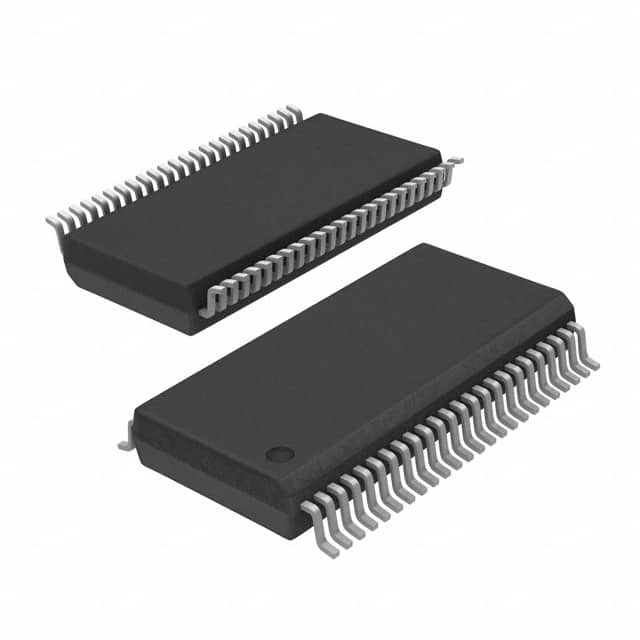Vedi le specifiche per i dettagli del prodotto.

Encyclopedia Entry: 74ALVCH162334DLRG4
Product Information Overview
Category: Integrated Circuit (IC)
Use: The 74ALVCH162334DLRG4 is a high-performance, low-voltage, 16-bit universal bus transceiver with 3-state outputs. It is designed for asynchronous communication between data buses.
Characteristics: This IC operates at a low voltage range of 1.65V to 3.6V, making it suitable for battery-powered devices and other low-power applications. It features 3-state outputs, which allow multiple devices to share a common bus without interference. The 74ALVCH162334DLRG4 also has built-in protection against electrostatic discharge (ESD), ensuring reliable operation in various environments.
Package: The 74ALVCH162334DLRG4 comes in a small-outline integrated circuit (SOIC) package. This package provides compactness and ease of integration into electronic circuits.
Essence: The essence of the 74ALVCH162334DLRG4 lies in its ability to facilitate bidirectional data transfer between two independent buses while maintaining signal integrity and minimizing power consumption.
Packaging/Quantity: The 74ALVCH162334DLRG4 is typically sold in reels or tubes, containing a specific quantity of ICs per package. The exact packaging and quantity may vary depending on the supplier.
Specifications
- Supply Voltage Range: 1.65V to 3.6V
- Input/Output Compatibility: LVTTL/LVCMOS
- Number of Channels: 16
- Output Drive Capability: ±24mA
- Operating Temperature Range: -40°C to +85°C
- Propagation Delay Time: <5ns
Detailed Pin Configuration
The 74ALVCH162334DLRG4 has a total of 48 pins, which are assigned specific functions. The pin configuration is as follows:
- A1
- B1
- Y1
- GND
- A2
- B2
- Y2
- VCC
- A3
- B3
- Y3
- GND
- A4
- B4
- Y4
- VCC
- A5
- B5
- Y5
- GND
- A6
- B6
- Y6
- VCC
- A7
- B7
- Y7
- GND
- A8
- B8
- Y8
- VCC
- A9
- B9
- Y9
- GND
- A10
- B10
- Y10
- VCC
- A11
- B11
- Y11
- GND
- A12
- B12
- Y12
- VCC
Functional Features
- Bidirectional data transfer between two independent buses.
- 3-state outputs for bus sharing without interference.
- Low-voltage operation for power efficiency.
- Built-in ESD protection for enhanced reliability.
Advantages and Disadvantages
Advantages: - Low-voltage operation allows for compatibility with various systems. - 3-state outputs enable efficient bus sharing. - Built-in ESD protection ensures robustness in different environments. - High-performance characteristics provide fast data transfer.
Disadvantages: - Limited to 16-bit data transfer, may not be suitable for larger bus sizes. - Requires careful consideration of voltage compatibility with other components in the system.
Working Principles
The 74ALVCH162334DLRG4 operates by receiving data from one bus and transmitting it to another. It uses a bidirectional transceiver architecture, allowing data to flow in both directions. The 3-state outputs enable multiple devices to share the same bus without causing conflicts or signal degradation. The IC's low-voltage operation ensures power efficiency, while the built-in ESD protection safeguards against electrostatic discharge events.
Detailed Application Field Plans
The 74ALVCH162334DLRG4 finds applications in various fields where bidirectional data transfer between independent buses is required. Some specific application areas include:
- Embedded Systems: Used for communication between microcontrollers and peripheral devices.
- Networking Equipment: Facilitates data exchange between different network interfaces.
- Industrial Automation: Enables communication between control systems and sensors/actuators.
- Consumer Electronics: Supports data transfer between different subsystems within electronic devices.
- Automotive Electronics: Used in automotive communication protocols like CAN (Controller Area Network).
Detailed and Complete Alternative Models
- SN
10 domande e risposte comuni relative all'applicazione di 74ALVCH162334DLRG4 nelle soluzioni tecniche
Sure! Here are 10 common questions and answers related to the application of 74ALVCH162334DLRG4 in technical solutions:
Q: What is the function of the 74ALVCH162334DLRG4? A: The 74ALVCH162334DLRG4 is a 16-bit universal bus transceiver with 3-state outputs.
Q: What voltage levels does the 74ALVCH162334DLRG4 support? A: The 74ALVCH162334DLRG4 supports both 3.3V and 5V voltage levels.
Q: Can the 74ALVCH162334DLRG4 be used for bidirectional data transfer? A: Yes, the 74ALVCH162334DLRG4 can be used for bidirectional data transfer.
Q: What is the maximum operating frequency of the 74ALVCH162334DLRG4? A: The maximum operating frequency of the 74ALVCH162334DLRG4 is typically around 400MHz.
Q: Does the 74ALVCH162334DLRG4 have built-in ESD protection? A: Yes, the 74ALVCH162334DLRG4 has built-in ESD protection on all inputs and outputs.
Q: Can the 74ALVCH162334DLRG4 be used in automotive applications? A: Yes, the 74ALVCH162334DLRG4 is qualified for automotive applications and meets the necessary standards.
Q: How many 74ALVCH162334DLRG4 devices can be connected together on a bus? A: Multiple 74ALVCH162334DLRG4 devices can be connected together on a bus, as long as the total capacitance and loading conditions are within the specified limits.
Q: Does the 74ALVCH162334DLRG4 have any power-saving features? A: Yes, the 74ALVCH162334DLRG4 has a power-down mode that reduces power consumption when not in use.
Q: Can the 74ALVCH162334DLRG4 tolerate overvoltage conditions? A: The 74ALVCH162334DLRG4 has input voltage tolerance up to 5.5V, making it tolerant to overvoltage conditions.
Q: Are there any specific layout considerations for using the 74ALVCH162334DLRG4? A: It is recommended to follow the layout guidelines provided in the datasheet to ensure proper signal integrity and minimize noise coupling.
Please note that these answers are general and may vary depending on the specific application and requirements. Always refer to the datasheet and consult with an expert for accurate information.

